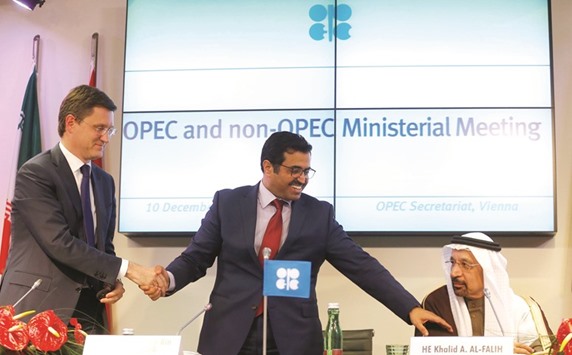Opec and non-Opec producers yesterday reached their first deal since 2001 to curtail oil output jointly and ease a global glut after more than two years of low prices that overstretched many budgets and spurred unrest in some countries.
With the deal finally signed after almost a year of arguing within the Organisation of the Petroleum Exporting Countries and mistrust in the willingness of non-Opec Russia to play ball, the market’s focus will now switch to compliance with the agreement.
Some Opec members have a long history of cheating on output quotas.
The fact that Nigeria and Libya were exempt from the deal due to production-denting civil strife will further pressure Opec leader Saudi Arabia to shoulder the bulk of supply reductions.
Russia, which 15 years ago failed to deliver on promises to cut in tandem with Opec, is expected to perform real output reductions this time.
But analysts question whether many other non-Opec producers are attempting to present a natural decline in output as their contribution to the deal.
“This is a very historic meeting...This will boost the global economy and will help some OECD countries to reach their inflation targets,” Opec secretary-general Mohammed Barkindo told reporters ahead of the talks, referring to the Organisation for Economic Cooperation and Development, which groups most of the world’s richest economies.
Last week, Opec agreed to slash output by 1.2mn bpd from January 1, with top exporter Saudi Arabia cutting as much as 486,000 bpd.
Yesterday, producers from outside the 13-country group agreed to reduce output by 562,000 bpd, slightly short of the initial target of 600,000 bpd, according to two Opec sources.
“They are all enjoying higher prices and compliance tends to be good in the early stages. But then as prices continue to rise, compliance will erode,” said veteran Opec watcher and founder of Pira Energy consultancy Gary Ross.
“Non-Opec has also made the largest contribution we have ever seen,” said Ross, adding that he believed Russia would curtail output in line with its pledge of 300,000 bpd. He added Opec would target an oil price of $60 per barrel as anything above that could encourage rival production.
Oil prices have more than halved in the past two years after Saudi Arabia raised output steeply in an attempt to drive higher-cost producers such as US shale firms out of the market.
The plunge in oil to below $50 per barrel – and sometimes even below $30 – from as high as $115 in mid-2014 has helped reduce growth in US shale output. But it also hit the revenues of oil-dependent economies including Saudi Arabia and Russia, prompting the two largest exporters of crude to start their first oil cooperation talks in 15 years.
Apart from Russia, the talks yesterday were attended by or had comments or commitments sent from non-Opec members Azerbaijan, Bahrain, Bolivia, Brunei, Equatorial Guinea, Kazakhstan, Malaysia, Mexico, Oman, Sudan and South Sudan.
Many non-Opec countries such as Mexico and Azerbaijan face a natural drop in oil production and some analysts expressed doubts those declines should be counted as cuts. Page 3

From left: Russia’s Energy Minister Alexander Novak; Opec President and Qatar’s Minister of Energy and Industry HE Dr Mohamed bin Saleh al-Sada and Saudi Arabia’s Energy Minister Khalid al-Falih shake hands after a news conference following a meeting at the Organisation of the Petroleum Exporting Countries headquarters in Vienna yesterday.
